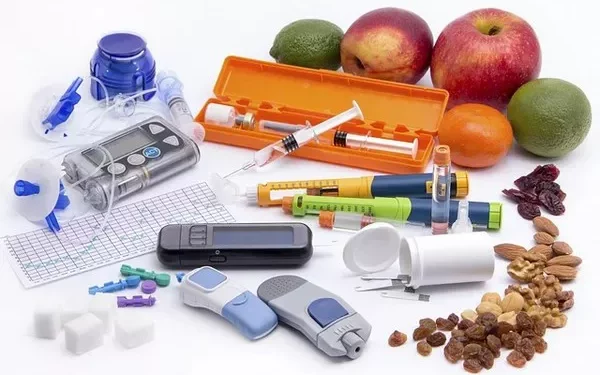Diabetes mellitus, particularly type 2 diabetes, is a chronic metabolic disorder characterized by elevated blood glucose levels due to insulin resistance and/or insufficient insulin production. Managing this condition requires a comprehensive approach that includes lifestyle changes, medication, monitoring, and education. This article will explore the recommended treatments for diabetes mellitus, focusing on evidence-based practices to achieve optimal blood sugar control and prevent complications.
Understanding Diabetes Mellitus
Diabetes mellitus is primarily categorized into three types: type 1 diabetes, type 2 diabetes, and gestational diabetes. Type 2 diabetes is the most common, accounting for approximately 90-95% of all diabetes cases. It typically develops in adults but is increasingly seen in younger populations due to rising obesity rates and sedentary lifestyles.
The pathophysiology of type 2 diabetes involves insulin resistance, where the body’s cells do not respond effectively to insulin, and a progressive decline in pancreatic beta-cell function, which leads to decreased insulin secretion. This dual defect results in chronic hyperglycemia, which, if left untreated, can lead to serious complications such as cardiovascular disease, neuropathy, nephropathy, and retinopathy.
Lifestyle Modifications
Dietary Changes
Dietary management is a cornerstone of diabetes treatment. The primary goals are to achieve and maintain a healthy body weight, manage blood glucose levels, and reduce the risk of cardiovascular disease.
Balanced Diet: A balanced diet rich in whole grains, vegetables, fruits, lean proteins, and healthy fats is recommended. Carbohydrates should be monitored closely, as they have the most significant impact on blood sugar levels. The concept of the glycemic index (GI) is useful, as it ranks carbohydrates based on their effect on blood glucose. Low-GI foods, such as legumes, whole grains, and non-starchy vegetables, are preferred.
Portion Control: Controlling portion sizes is essential to avoid excessive calorie intake and weight gain. This is particularly important for managing type 2 diabetes, where obesity is a major risk factor.
Meal Timing: Regular meal timing helps maintain steady blood sugar levels. Some individuals may benefit from smaller, more frequent meals throughout the day to prevent large fluctuations in glucose levels.
Specific Dietary Plans: Several dietary patterns have been shown to be effective for managing diabetes, including the Mediterranean diet, DASH (Dietary Approaches to Stop Hypertension) diet, and plant-based diets. These diets emphasize whole foods, healthy fats, and limited intake of processed foods and sugars.
Physical Activity
Regular physical activity improves insulin sensitivity, aids in weight management, and reduces cardiovascular risk. Exercise facilitates glucose uptake by muscles, which can lead to lower blood sugar levels.
Aerobic Exercise: Activities such as walking, cycling, swimming, and jogging are recommended for at least 150 minutes per week. Aerobic exercise has been shown to improve cardiovascular health and help with weight loss.
Resistance Training: Incorporating resistance or strength training two to three times per week helps build muscle mass and enhances insulin sensitivity. Resistance training can be done using free weights, resistance bands, or bodyweight exercises.
Flexibility and Balance Exercises: Exercises such as yoga and tai chi can improve flexibility, balance, and overall well-being. These practices can be particularly beneficial for older adults with diabetes to reduce the risk of falls and improve mobility.
Weight Management
Achieving and maintaining a healthy weight is critical in managing type 2 diabetes. Even modest weight loss (5-10% of body weight) can lead to significant improvements in blood glucose levels and insulin sensitivity.
Weight Loss Strategies: Effective weight loss strategies include a combination of dietary changes, increased physical activity, behavioral therapy, and, in some cases, pharmacotherapy or bariatric surgery for individuals with severe obesity.
Pharmacological Treatments
When lifestyle modifications alone are insufficient to achieve glycemic control, pharmacological interventions are required. The choice of medication depends on various factors, including the individual’s blood sugar levels, comorbidities, risk of hypoglycemia, and preferences.
Metformin
Metformin is the first-line medication for type 2 diabetes and is often prescribed immediately upon diagnosis. It works by reducing hepatic glucose production, enhancing insulin sensitivity, and improving peripheral glucose uptake. Metformin is generally well-tolerated, with gastrointestinal side effects being the most common.
Benefits of Metformin:
- It does not cause hypoglycemia when used as monotherapy.
- It may contribute to modest weight loss.
- It has a favorable effect on cardiovascular outcomes.
Sulfonylureas
Sulfonylureas, such as glipizide and glimepiride, stimulate insulin secretion from pancreatic beta cells. They are effective in lowering blood glucose levels but carry a risk of hypoglycemia and may contribute to weight gain.
Considerations:
- They are often used as add-on therapy to metformin.
- Close monitoring is required to avoid hypoglycemia, especially in the elderly.
DPP-4 Inhibitors
Dipeptidyl peptidase-4 (DPP-4) inhibitors, such as sitagliptin and saxagliptin, work by enhancing the activity of incretin hormones, which increase insulin release and decrease glucagon production in a glucose-dependent manner.
Advantages:
- They have a low risk of hypoglycemia.
- They are weight-neutral.
GLP-1 Receptor Agonists
Glucagon-like peptide-1 (GLP-1) receptor agonists, such as liraglutide and semaglutide, mimic the effects of the GLP-1 hormone, which enhances insulin secretion, inhibits glucagon release, slows gastric emptying, and promotes satiety.
Benefits:
- They are effective in lowering blood glucose and promoting weight loss.
- Some GLP-1 receptor agonists have been shown to reduce cardiovascular risk.
SGLT2 Inhibitors
Sodium-glucose cotransporter-2 (SGLT2) inhibitors, such as empagliflozin and canagliflozin, work by inhibiting glucose reabsorption in the kidneys, leading to increased glucose excretion in the urine.
Advantages:
- They contribute to weight loss and blood pressure reduction.
- They have been shown to reduce the risk of heart failure and renal disease.
Insulin Therapy
Insulin therapy is necessary for individuals with type 2 diabetes who do not achieve adequate glycemic control with oral or non-insulin injectable medications. It is also indicated for individuals with significant hyperglycemia at diagnosis or during periods of illness or stress.
Types of Insulin:
Basal Insulin: Long-acting insulin (e.g., insulin glargine, insulin detemir) provides a steady level of insulin to control fasting blood glucose levels.
Prandial Insulin: Rapid-acting insulin (e.g., insulin aspart, insulin lispro) is used to control blood glucose spikes after meals.
Premixed Insulin: Combines both basal and prandial insulin in one injection for simplicity.
Considerations:
- Insulin therapy requires careful monitoring of blood glucose levels to adjust doses and avoid hypoglycemia.
- Insulin can cause weight gain, so it is often used in conjunction with other medications that mitigate this effect.
Blood Sugar Monitoring
Regular blood sugar monitoring is essential for managing diabetes and adjusting treatment plans. Monitoring provides immediate feedback on the effectiveness of the treatment regimen and helps identify patterns that may require intervention.
Self-Monitoring of Blood Glucose (SMBG)
Self-monitoring of blood glucose involves using a glucose meter to check blood sugar levels at various times of the day, such as before and after meals and at bedtime.
Frequency of Monitoring:
- Individuals on insulin therapy may need to monitor their blood glucose levels multiple times per day.
- Those on oral medications may require less frequent monitoring, depending on their level of control.
Continuous Glucose Monitoring (CGM)
Continuous glucose monitoring provides real-time data on blood glucose levels through a sensor placed under the skin. CGM systems offer trend information, alerts for high or low blood sugar levels, and insights into glucose variability.
Benefits of CGM:
- It helps in fine-tuning insulin therapy and preventing hypoglycemia.
- It provides a more comprehensive picture of glucose control than SMBG alone.
HbA1c Testing
HbA1c, or glycated hemoglobin, reflects average blood glucose levels over the past 2-3 months. It is a key marker for assessing long-term glycemic control.
Target HbA1c Levels:
The general target for most individuals with diabetes is an HbA1c level of less than 7%. However, individualized targets may be set based on age, duration of diabetes, comorbidities, and risk of hypoglycemia.
Education and Support
Education and support are vital components of diabetes care. Individuals with diabetes should receive ongoing education about their condition, treatment options, and lifestyle management strategies.
Diabetes Self-Management Education and Support (DSMES)
DSMES programs provide individuals with the knowledge and skills needed to manage their diabetes effectively. Topics covered include healthy eating, physical activity, blood sugar monitoring, medication management, and problem-solving.
Benefits of DSMES:
- Improved glycemic control.
- Enhanced quality of life.
- Reduced risk of complications.
Psychological Support
Living with diabetes can be challenging, and psychological support is crucial for addressing issues such as diabetes distress, anxiety, and depression. Counseling, support groups, and stress management techniques can help individuals cope with the emotional aspects of diabetes.
Regular Follow-Up
Regular follow-up with healthcare providers is essential to monitor progress, adjust treatment plans, and address any concerns. Follow-up visits typically include reviewing blood sugar levels, medication adherence, lifestyle changes, and screening for complications.
Prevention and Management of Complications
Preventing and managing complications is a critical aspect of diabetes care. Chronic hyperglycemia can lead to both microvascular and macrovascular complications, which significantly impact quality of life and increase mortality.
Cardiovascular Disease
Cardiovascular disease is the leading cause of death in individuals with diabetes. Managing risk factors such as hypertension, dyslipidemia, and smoking cessation is essential.
Statin Therapy: Statins are recommended for individuals with diabetes who have an elevated risk of cardiovascular events. They help lower LDL cholesterol levels and reduce the risk of heart attack and stroke.
Antihypertensive Therapy: Controlling blood pressure is crucial in reducing the risk of cardiovascular and renal complications. ACE inhibitors, ARBs, and calcium channel blockers are commonly used.
Antiplatelet Therapy: Low-dose aspirin may be considered for individuals with diabetes who have a high risk of cardiovascular disease.
Diabetic Nephropathy
Diabetic nephropathy is a leading cause of chronic kidney disease. Early detection and management of elevated urinary albumin levels are critical.
ACE Inhibitors and ARBs: These medications help protect kidney function by reducing proteinuria and controlling blood pressure.
Glycemic Control: Maintaining good glycemic control is essential in slowing the progression of diabetic nephropathy.
Diabetic Retinopathy
Diabetic retinopathy is a leading cause of blindness in adults. Regular eye exams are crucial for early detection and treatment.
Laser Therapy: Laser photocoagulation can help prevent vision loss in individuals with proliferative diabetic retinopathy or macular edema.
Anti-VEGF Therapy: Intravitreal injections of anti-VEGF agents, such as ranibizumab, can improve vision in individuals with diabetic macular edema.
Diabetic Neuropathy
Diabetic neuropathy can cause a range of symptoms, including pain, numbness, and tingling in the extremities. Managing blood glucose levels is the primary strategy for preventing neuropathy.
Medications for Neuropathic Pain: Medications such as gabapentin, pregabalin, and duloxetine are commonly used to manage neuropathic pain.
Foot Care: Proper foot care is essential to prevent ulcers and infections. Individuals with diabetes should inspect their feet daily, wear appropriate footwear, and seek prompt medical attention for any sores or injuries.
Emerging Therapies and Future Directions
Research in diabetes treatment is ongoing, with new therapies and technologies on the horizon. These advancements hold promise for improving outcomes and quality of life for individuals with diabetes.
Novel Medications
New classes of medications, such as dual GLP-1/GIP receptor agonists and SGLT1/2 inhibitors, are being developed and tested in clinical trials. These drugs may offer additional benefits in glucose control, weight management, and cardiovascular protection.
Artificial Pancreas Systems
Artificial pancreas systems, which combine insulin pumps with continuous glucose monitors and sophisticated algorithms, are being refined to provide automated and precise insulin delivery. These systems aim to mimic the function of a healthy pancreas and reduce the burden of diabetes management.
Stem Cell Therapy
Stem cell therapy holds potential for regenerating insulin-producing beta cells in individuals with type 1 diabetes. While still in the experimental stage, this approach could offer a cure for diabetes in the future.
See also: What Type of Diabetes Can Be Prevented?
Conclusion
The treatment of diabetes mellitus, particularly type 2 diabetes, requires a multifaceted approach that includes lifestyle modifications, pharmacological therapy, blood sugar monitoring, education, and complication management. Each individual’s treatment plan should be tailored to their specific needs, preferences, and risk factors. By following evidence-based guidelines and staying informed about emerging therapies, healthcare providers can help individuals with diabetes achieve optimal outcomes and lead healthy, fulfilling lives.
Related topics:
What are the Symptoms of Sudden High Blood Sugar



























